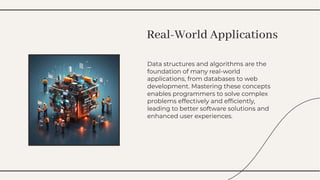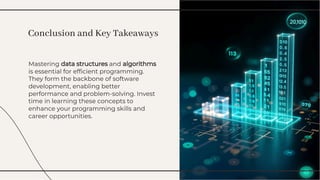slidesgo-mastering-data-structures-and-algorithms-the-backbone-of-efficient-programming-2025012.pdf
- 1. Mastering Data Structures and Algorithms: The Backbone of Efficient Programming Mastering Data Structures and Algorithms: The Backbone of Efficient Programming
- 2. Introduction to Data Structures Introduction to Data Structures In this presentation, we will explore the fundamentals of data structures and algorithms. Understanding these concepts is crucial for efficient programming and problem-solving. We will delve into various types of data structures, their purposes, and how they enhance performance. In this presentation, we will explore the fundamentals of data structures and algorithms. Understanding these concepts is crucial for efficient programming and problem-solving. We will delve into various types of data structures, their purposes, and how they enhance performance.
- 3. Data structures are specialized formats for organizing, processing, and storing data. They enable efficient access and modification of data, which is essential in programming. Different data structures, such as arrays, stacks, and queues, serve unique purposes based on the requirements of the application. Data structures are specialized formats for organizing, processing, and storing data. They enable efficient access and modification of data, which is essential in programming. Different data structures, such as arrays, stacks, and queues, serve unique purposes based on the requirements of the application.
- 4. Algorithms are step-by-step procedures or formulas for solving problems. Their efficiency is measured in terms of time and space complexity. Mastering algorithms allows programmers to write more efficient code, leading to faster execution and reduced resource consumption. Algorithms are step-by-step procedures or formulas for solving problems. Their efficiency is measured in terms of time and space complexity. Mastering algorithms allows programmers to write more efficient code, leading to faster execution and reduced resource consumption.
- 5. Types of Data Structures Types of Data Structures Data structures can be classified into two main categories: primitive and non- primitive. Primitive structures include integers, floats, and characters, while non- primitive structures include arrays, linked lists, trees, and graphs. Each type has its own advantages and use cases. Data structures can be classified into two main categories: primitive and non- primitive. Primitive structures include integers, floats, and characters, while non- primitive structures include arrays, linked lists, trees, and graphs. Each type has its own advantages and use cases.
- 6. An array is a collection of items stored at contiguous memory locations. They allow for quick access to elements using an index. Arrays are widely used in programming for tasks that require fast data retrieval, such as sorting and searching algorithms. An array is a collection of items stored at contiguous memory locations. They allow for quick access to elements using an index. Arrays are widely used in programming for tasks that require fast data retrieval, such as sorting and searching algorithms.
- 7. A linked list is a linear data structure where elements are stored in nodes, each pointing to the next. This structure allows for dynamic memory allocation and efficient insertions and deletions. Linked lists are beneficial when the size of the data structure is not known in advance. A linked list is a linear data structure where elements are stored in nodes, each pointing to the next. This structure allows for dynamic memory allocation and efficient insertions and deletions. Linked lists are beneficial when the size of the data structure is not known in advance. Linked Lists Explained Linked Lists Explained
- 8. Stacks and Queues Stacks and Queues Stacks and queues are two essential abstract data types. A stack operates on a Last In First Out (LIFO) principle, while a queue follows First In First Out (FIFO). Both structures are used in various applications, including function call management and task scheduling. Stacks and queues are two essential abstract data types. A stack operates on a Last In First Out (LIFO) principle, while a queue follows First In First Out (FIFO). Both structures are used in various applications, including function call management and task scheduling.
- 9. A tree is a hierarchical data structure consisting of nodes connected by edges. It is used to represent relationships and hierarchies, such as file systems and organizational structures. Understanding trees is vital for mastering algorithms like binary search and tree traversals. A tree is a hierarchical data structure consisting of nodes connected by edges. It is used to represent relationships and hierarchies, such as file systems and organizational structures. Understanding trees is vital for mastering algorithms like binary search and tree traversals.
- 10. A graph is a collection of nodes connected by edges, representing complex relationships. Graphs can be directed or undirected, weighted or unweighted. They are widely used in networking, social media, and pathfinding algorithms, making them crucial for advanced programming. A graph is a collection of nodes connected by edges, representing complex relationships. Graphs can be directed or undirected, weighted or unweighted. They are widely used in networking, social media, and pathfinding algorithms, making them crucial for advanced programming.
- 11. Analyzing algorithms involves measuring their time and space complexity. Common techniques include Big O notation, which describes the upper limit of performance. Understanding these concepts helps developers choose the most efficient algorithms for their needs. Analyzing algorithms involves measuring their time and space complexity. Common techniques include Big O notation, which describes the upper limit of performance. Understanding these concepts helps developers choose the most efficient algorithms for their needs.
- 12. Data structures and algorithms are the foundation of many real-world applications, from databases to web development. Mastering these concepts enables programmers to solve complex problems effectively and efficiently, leading to better software solutions and enhanced user experiences. Data structures and algorithms are the foundation of many real-world applications, from databases to web development. Mastering these concepts enables programmers to solve complex problems effectively and efficiently, leading to better software solutions and enhanced user experiences. Real-World Applications Real-World Applications
- 13. Mastering data structures and algorithms is essential for efficient programming. They form the backbone of software development, enabling better performance and problem-solving. Invest time in learning these concepts to enhance your programming skills and career opportunities. Mastering data structures and algorithms is essential for efficient programming. They form the backbone of software development, enabling better performance and problem-solving. Invest time in learning these concepts to enhance your programming skills and career opportunities. Conclusion and Key Takeaways Conclusion and Key Takeaways
- 14. Thanks! Thanks! Do you have any questions? [email protected] +91 620 421 838 www.yourwebsite.com @yourusername Do you have any questions? [email protected] +91 620 421 838 www.yourwebsite.com @yourusername













